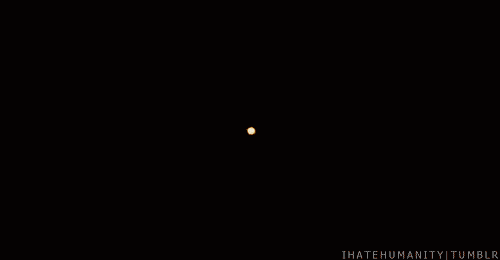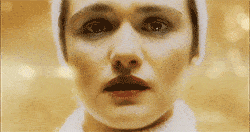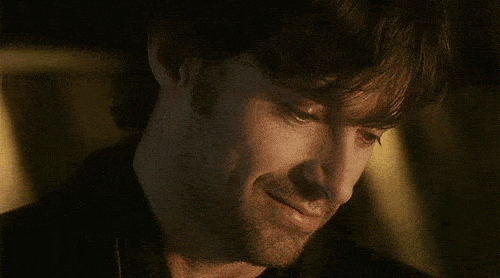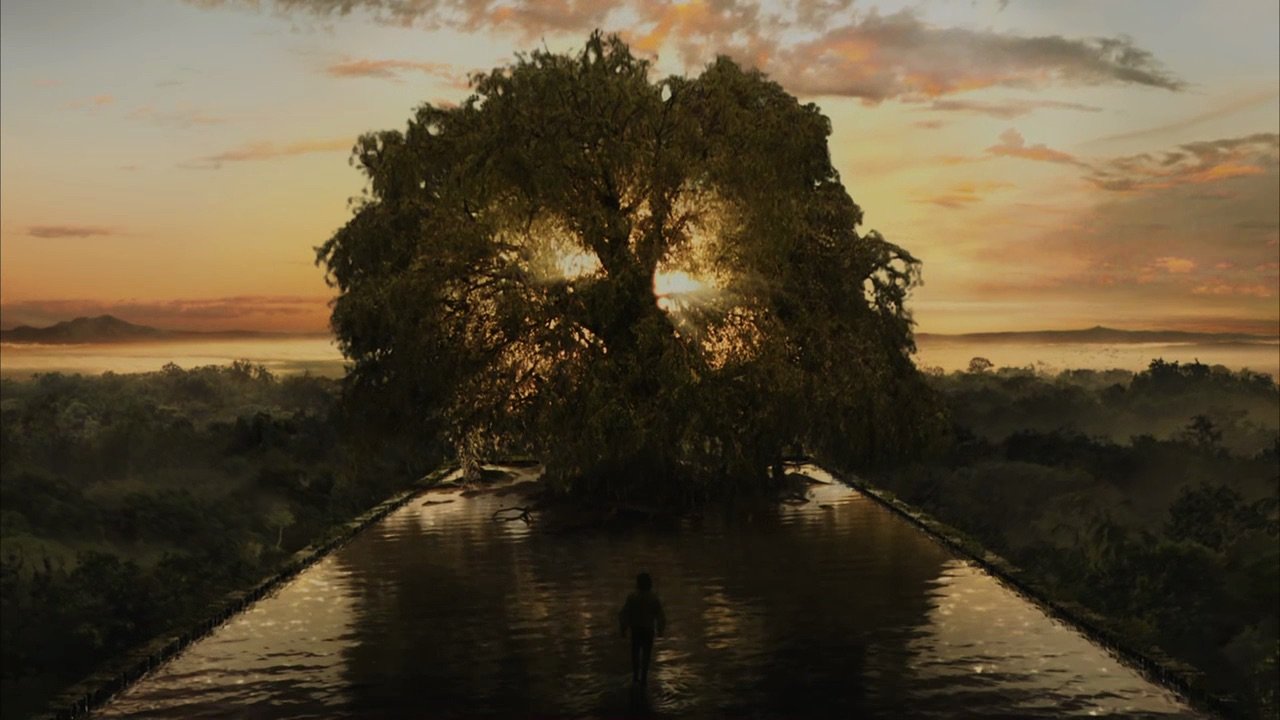The Fountain makes things difficult by being three separate stories. And the lines are blurred between what is real and what isn’t real. To that end, there’s arguments to be made for a very fantastical reading of the film and then a very grounded reading.
Regardless of the path we choose to walk, a grounded one or a fantastic one, there’s a universal theme.
Izzi is sick and dying. More importantly, she is ready to die. She’s accepted that the end is close.
Tom struggles with this. He’s overwhelmed at the thought of losing his wife. Instead of spending with her what precious time they have left…Tom stays in the lab trying to find a cure. He clams up whenever Izzi wants to talk about death. He’s…having a hard time. Understandably so. But by the end of the movie he’s had a profound and cathartic experience that brings him an idea of peace.
This is the overarching concept of the film: a character moving from a fear of death to a peaceful relationship with mortality. I think everything that this movie says about death can also be applied to loss in general. We can’t let loss or the fear of loss limit us or consume us. Instead, we must let those things educate us, enlighten us. In confronting her own mortality, Izzi discovered a newfound beauty in the world. And she found inspiration for creativity. Likewise, in accepting Izzi’s mortality, Tom shared that same discovery and inspiration.
But what actually happens in the story?
The fantastic path
If we walk the fantastic path, then we look at all three storylines existing in reality. Tom was the conquistador, he is the neuroscientist, and he will be the space traveler.
While there are gaps of centuries between each timeline, there’s interaction between all three. The tree the conquistador finds is the source of the miracle cure that the neuroscientist discovers. And the space traveler’s story creates a seed that is passed through time to the neuroscientist to bury at Izzi’s grave. At one point, an ancient Mayan sees the conquistador as the space traveler.
Essentially, the conquistador’s life allowed for the neuroscientist to become the space traveller and that the space traveller eventually reaches a star system that is the Maya underworld, Xibalba. The star system really does seem to have rebirth properties, as the dead tree in the space bubble bursts to life. We then see Izzi, alive again, pick a seed from the revitalized tree.
In this ending, the implication is that Tom reaches some afterlife with Izzi that allows them to be together again. It’s a happy ending that resonates with our hopes for an afterlife. The major issue here is understanding the mechanics that could possibly lead to the interactions between timelines. Unlike a movie like Looper that takes pains to try and make the time-travel aspects believable, The Fountain leaves us without explicit answers. The how and why of what happened isn’t considered, just the what. We could chalk it up to a notion of pre-determination, that everything has already happened, that time isn’t linear but completely free-form.

The grounded path
Izzi mentions she was working on a novel that we find out is called The Fountain. That novel is about the conquistador, Tomas, or so Tom thought. Izzi hints that it only begins in Spain, but “ends there” she says, meaning the dying star Xibalba they had been looking at through a telescope.
Before she dies, Izzi requests Tom finish writing the novel. She says it’s only the final chapter that remains.
We know then from these details that the novel includes at least the conquistador and the space traveler heading towards Xibalba. This makes The Fountain a fundamentally different movie. In the fantastic version of events, The Fountain is an epic love story that transcends space and time. But in the grounded version…it’s actually Izzi’s novel. Which makes it one of the most bittersweet things I’ve ever experienced.

Tom is a wreck after Izzi’s death, but Tom uses Izzi’s novel about the conquistador and space traveler to work through his grief, his guilt at not spending more time with Izzi, and his fear of death. The novel allows him to create a world in which he and Izzi do get to be together forever. That’s a world that will never exist in reality. Because in reality there’s no bringing Izzi back from the dead. People don’t really live on in trees. They die. And we have to go on without them. But through his experience of finishing the novel Tom achieves a sense of peace.
We see that tranquility in the final scene. Tom plants the seed at Izzi’s grave, a symbolic gesture. One that is as much about hope as it is about closure.
There could be two ways of understanding the novel and thus the “grounded” version of the movie.
In version one: we only have the conquistador and the space traveler. All the scenes of present-day Tom are outside of the novel, meaning they happen in the “reality” of the movie.
In version two: the novel includes the present-day Tom. Which would mean the entire movie is the novel and we never see the reality the novel exists in.
There are two reasons we have to consider version two.
First, Izzi handing the seed to present-day Tom. That moment could be the very end of the novel, something like, “And Izzi, dressed for winter, stood amidst the lushness of the reborn tree, smiling at its bloom. She picked a seed from a branch and held the seed in the warmth of her open palm, waiting for you to take it. THE END” Izzi had told Tom the story of the Mayan man who had a seed planted at his grave and his spirit grew into the tree. Obviously Izzi’s novel drew heavily from this story. It would make sense that Tom conclude the novel with the arrival of the seed that explains then how Izzi became part of the tree in the space traveler’s narrative. But, it would be a strange to end with her handing the seed to the reader? Otherwise, who is she handing it to? The only other logical answer, based on what we see in the movie, would be Tom in the present.
Second, is that as Tom moves into his “finish it” phase of things that begins the “road to awe”, we see a scene from the present day repeat. It’s the one from early in the film when Izzi visits Tom at the hospital and asks him to take a walk with her. Tom refuses, opting instead to perform a surgery he hopes will lead to a cure for Izzi. In his mind, he’s made the short-term sacrifice for a chance at long-term gain. But he regrets this decision. Because there is no defeating death, and he understands that now. So, instead, in this repeat scene, we see Tom refuse the surgery. He follows Izzi outside, into the snow. The moment he catches up with her we transition to space traveler reaching the tree, climbing it, and launching into space within his even smaller bubble.
Izzi handing the seed can be explained as the end of the book. But the repeated scene is a little more complicated. Is it a random daydream of Tom’s? It would be the only time in the entire movie that we have such a daydream. That would make it a weird outlier, the kind of mistake an amateur would make. The Fountain doesn’t have any obvious mistakes like this though, meaning that it’s probably not a mistake, meaning it’s probably not a random daydream. What is it then?
Right before this, we have the space traveler telling the tree “We will live forever.” Present day Izzi appears in the bubble and tells the space traveler to “Finish it,” referring to the novel. The traveler responds with, “Ok.” That acceptance is a far cry from the response Tom had had when Izzi, on her death bed, had requested he finish the novel. He had refused, acted confused, didn’t want to entertain the idea that he would have to because it would mean that Izzi had died…something he still was struggling with.
At this point, though? Our space traveler had just said a few times, “I’m going to die” and said that to the ghost of present day Izzi. He had smiled and laughed and cried while saying it, admitting it for the first time, coming to terms with it for the first time. It makes sense then that he can now accept finishing the novel.
That would then mean that the repeated scene of Tom and Izzi is part of the novel, is probably the beginning of what Tom is writing. It and everything that follows is the final chapter.
But the only way that repeated scene makes sense in the novel is if the present day events had been part of the novel from the beginning. I think this lends weight to the idea that the entire movie is the novel. Especially when the movie title is the same as the novel title.
Endings endings endings, which one do I pick?

Personally, I think Aronofsky structured The Fountain carefully enough that whatever ending you like best is the one you should go with. There’s arguments to be made for the fantastic ending, for the grounded ending, and for the novel being the movie. That’s less a failure and more a testament to Aronofsky’s structuring.

